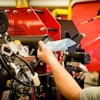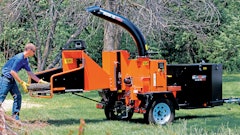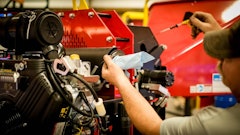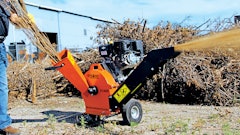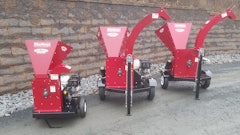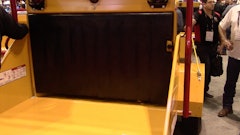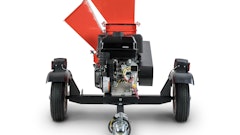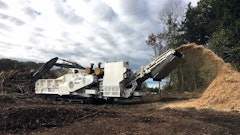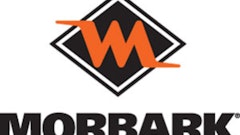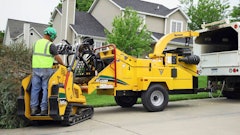Well--maintained chipper can be a highly efficient tool for processing debris on construction jobsites. That efficiency, however, can be quickly diminished if the operator ignores basic maintenance tips that keep chippers in top operating condition.
One of the biggest causes of unscheduled downtime for chippers is feeding materials such as metal, stones or dirt into the machine, says Rob Faber, commercial sales specialist at Morbark Inc. This can dull and chip knives quickly.
“In construction applications, a lot of times there are rocks and other foreign materials that might be in the brush pile that don’t get taken out and get thrown through the chipper,” he notes. “That can cause serious maintenance issues.” Faber suggests operators carefully sort through material piles to ensure nothing gets thrown into the chipper that could damage it.
Another common problem is putting too much material into the machine. “Some operators try to force feed the chipper with a knuckleboom, backhoe or skid steer--type loader,” says Leslie Kinnee at Bandit Industries. “In doing this, the material tends to be larger than the chipper’s capacity.” She explains that this is hard on a machine, leads to jams and can damage the chipper’s feed system.
Improper use of the clutch must also be avoided, including engaging the clutch at improper rpms. “A lot of contractors who don’t operate chippers on a full--time basis might think that since they have a 12--in.--capacity machine, but are only running 5-- or 6--in. material, they don’t need to have full rpm to chip because they’re not chipping big material. They’ll run it at half rpm,” says Faber. “For the machine to operate properly it must run at full rpm at all times, no matter what you’re chipping.”
Another common mistake is trying to unplug the chipper with the clutch. Sometimes an operator will attempt to dislodge materials wedged in the drum or disk by starting the engine, disengaging the clutch, then trying to force the disk or drum to turn again by jamming the clutch in. This will also cause premature clutch wear or failure.
Preventive Maintenance
To get the most efficiency out of your chipper and to avoid unnecessary downtime, it’s important to establish a scheduled preventive maintenance program. This includes mapping out the daily, weekly and monthly maintenance checks, and making sure operators follow them diligently. The operator’s manual will provide specific guidelines for your equipment. However, following are some general steps that should be included in your PM program.
On a daily basis, check the chipper to make sure it is operating correctly. In general, you should:
The most important daily check for chippers is knife sharpness. “The sharper your knife edges are, the easier it is to cut material and the better the cut is,” says Scott Polacek, project manager at MB Companies. “As edges become dull, it requires more horsepower to cut and your chips are not as clean looking. Dull knives are more destructive to the materials you’re trying to cut--it blows the material apart instead of cutting through it cleanly.”
“If you have dull blades, blades that aren’t maintained or poor shear bar adjustment, you can add unnecessary vibration to the machine, which can lead to part problems or failures at other points,” adds Chris Nichols, product manager for the environmental product group at Vermeer Mfg. Co. “Vibration can also really take away from the overall life of the machine if you let it work under severe vibration for a long length of time.”
General weekly examinations should include checking tire pressure, battery level, the alternator and fan belts on the engine and anvil clearance, tightness and wear. Also check and retighten the fuel tank and hydraulic tank mount bolts and wheel lug nuts.
On a monthly basis, check the towing hitch for wear, and grease the pintle ring. You should also examine the discharge and infeed hopper for wear, and inspect feed wheel teeth for sharpness.
Polacek has another suggestion for eliminating downtime. “One thing some people do that helps is they have spare parts on hand, for instance, an extra set of knives. That way they don’t have to send the knives out to be sharpened if they need changing. You pretty much eliminate downtime except for the time it takes to change the knives,” he explains.
Maintenance Safety
Safety is important to keep in mind when servicing a chipper. During service, it’s a good idea to have the ignition keys in your pocket to prevent accidental starting. Nichols also emphasizes the importance of making sure moving parts have stopped before you open covers or bypass safety features. “When you have a machine running at full rpm and you turn off the engine, that blade is going to coast for a fair amount of time. If you’re going in the machine to inspect, change or sharpen blades, you’re going to want to make sure that blade has stopped,” he says. “Vermeer uses a timing test. Our bolts are a certain length and there are a certain number of them, so the time the disk needs to stop doesn’t exceed the time it would take a guy with a socket wrench to get inside the machine.”
When servicing a chipper, follow the same basic safety measures you would take if you were operating one. For instance, wear tight--fitting clothing, avoid any loose articles that could get caught on the machine and make sure your work area is clean. Polacek adds, “With all the sharp parts on these machines, it helps if you have gloves. But putting a rag over sharp edges when you’re handling parts also minimizes the risk of cuts if you drop something, if it slides through your hands or when you’re handing parts from one person to another.”
Operational Safety
When operating a chipper, common sense is key to preventing mishaps. The dangers chippers present are evident when you’re standing next to one -- a machine powerful enough to tear a piece of wood into thousands of tiny bits won’t have much trouble damaging a fleshy arm or leg. So don’t put your hand near the infeed, and never use your leg to stomp or shove wood through the machine.
A helmet, safety glasses or even a face guard can help protect you from flying brush, and ear protection will guard against loud chipper noise. Wear pants and long--sleeved shirts to avoid being scratched or cut by sharp limbs and brush, and make sure clothing is tight--fitting to avoid becoming entangled in the chipper.
Also avoid neckties, jewelry, watches or anything else that could get caught in a chipper and pull you in. Gloves are important to wear when using a chipper, but avoid gauntlet style gloves, or those with large cuffs.
Never operate a chipper that’s in need of service. Always make sure someone else is around during operation -- if something happens, you want someone there to help you.
Bandit’s Leslie Kinnee suggests that all chipper operators should periodically take time to read and make sure they understand the operator’s manual. “Even seasoned operators need a refresher,” she says. “The operator’s safety, and the safety of those in the vicinity of the machine, are dependent on the operator’s knowledge of how to safely operate and maintain the unit.”
When it comes to the safety of others, number one is choosing a safe place for chipper operation. “When you’re operating near or on a street, keep the chipper away from traffic, bystanders, kids, pets or anything else,” says Scott Polacek at MB Companies. “Ensure the chipper discharge is pointed in a safe direction. If possible, mark off your work area.”
Polacek also suggests having only one operator working with the chipper at a time. “People have a tendency to get into a danger zone near where the discharge area is, or trip over limbs, or the partner they’re working with gets whipped in the face with the material they’re hauling around,” he points out.


